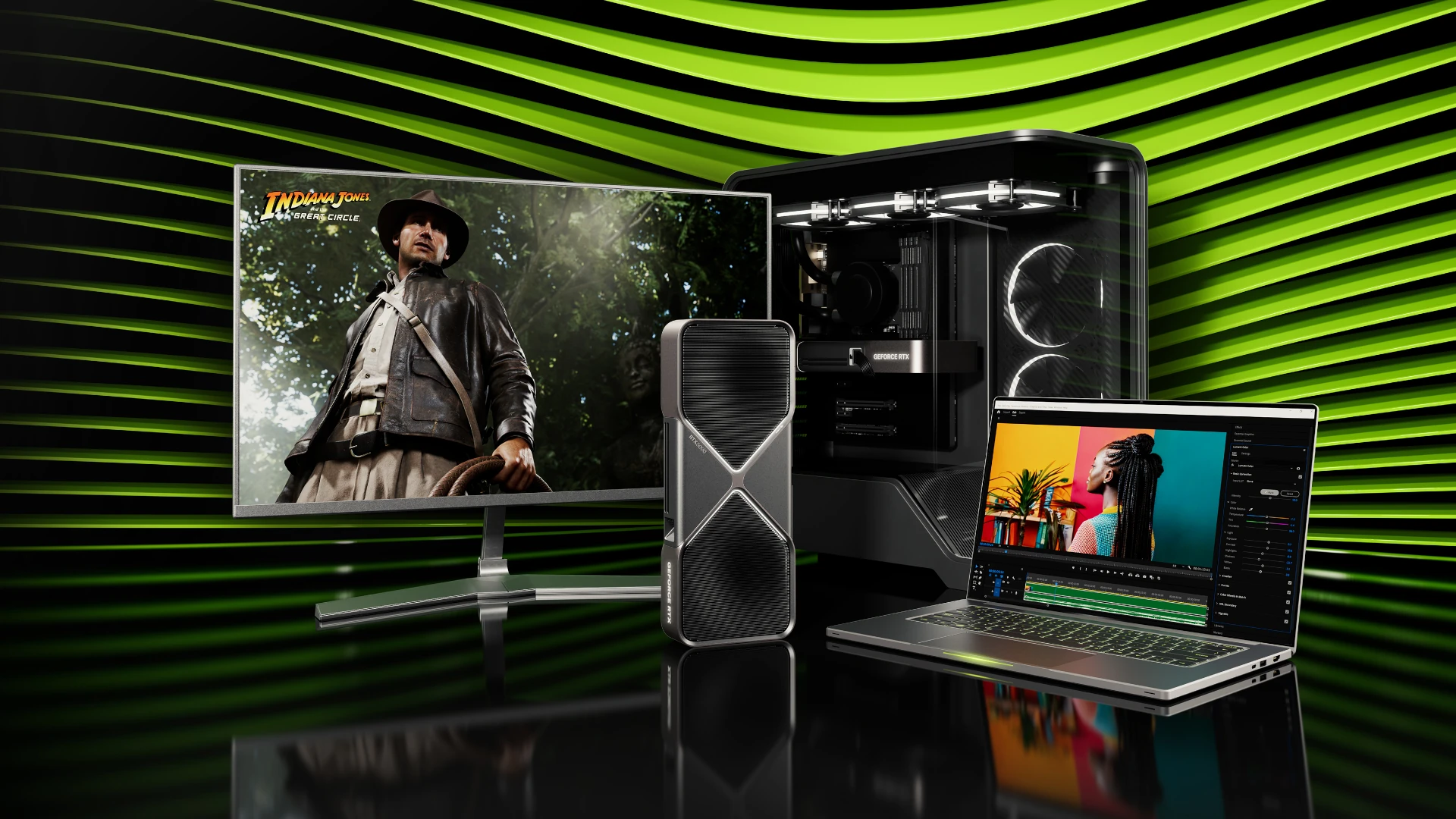NVIDIA has officially revealed its GeForce RTX 50 Series at CES 2025. This series marks a big step forward in performance and graphics technology thanks to the new Blackwell architecture, which focuses on AI-driven rendering and neural networking. With the RTX 50 Series, NVIDIA continues to raise expectations for graphics technology. The mix of AI, advanced rendering techniques, and strong performance confirms NVIDIA’s leading role in graphics processing.
Gamers and professional creators are excited about these new GPUs and the potential of the Blackwell architecture. The gaming world is about to change, and NVIDIA is at the forefront of this shift. The launch of the GeForce RTX 50 Series GPUs at CES 2025 is a key moment in the growth of PC gaming. The new lineup, built on the Blackwell architecture and featuring improvements like DLSS 4 and better ray tracing, promises much better performance than the last generation.
With the RTX 5090 leading the way, NVIDIA is setting a new benchmark for graphics power and AI features, which will create more immersive and visually impressive gaming experiences. Gamers and content creators are eager to use these powerful GPUs for gaming, creative projects, and more.
NVidia’s Next Generation: GeForce RTX 50 Series GPUs Unveiled at CES
A New Era of Graphics Processing
At CES 2025, NVidia took the wraps off its highly anticipated GeForce RTX 50 series graphics cards. This new lineup, led by the powerful RTX 5090, promises to redefine gaming and content creation with significant performance enhancements and innovative features. The initial announcement included four GPUs: the RTX 5090, RTX 5080, RTX 5070 Ti, and RTX 5070.
Availability and Pricing
Gamers eager to get their hands on these new GPUs won’t have to wait long. The RTX 5090 and RTX 5080 are slated for release on January 30, 2025, with prices set at $1,999 and $999, respectively. The RTX 5070 Ti and RTX 5070 will follow in February, priced at $749 and $549.
Blackwell Architecture and Performance
The RTX 50 series is built on NVidia’s new Blackwell architecture, designed to deliver a substantial performance boost over the previous generation. The flagship RTX 5090 boasts over 21,000 CUDA cores and 32 GB of GDDR7 memory, making it a powerhouse for gaming and creative workloads.
NVidia CEO Jensen Huang claimed that the RTX 5090 is up to twice as fast as the RTX 4090, particularly in games that utilize ray tracing and DLSS. These claims, while impressive, will need to be verified by independent benchmarks.
DLSS 4 and Ray Tracing Advancements
The RTX 50 series introduces DLSS 4, the latest version of NVidia’s AI-powered upscaling technology. DLSS 4 brings new features like Multi Frame Generation, which can generate intermediate frames to further boost performance. This technology, combined with enhanced ray tracing capabilities, promises to deliver stunning visuals and smooth frame rates in supported games.
Additional Features and Technologies
The RTX 50 series also includes several other notable features:
- NVIDIA Reflex 2: Reduces system latency for a more responsive gaming experience.
- NVIDIA Broadcast: Enhances live streams and video calls with AI-powered features.
- AV1 Encoding and Decoding: Supports the latest video codec for improved video quality and efficiency.
Comparison Table
| GPU | Launch Date | Price | CUDA Cores | Memory |
|---|---|---|---|---|
| RTX 5090 | January 30, 2025 | $1,999 | 21760 | 32 GB GDDR7 |
| RTX 5080 | January 30, 2025 | $999 | 10752 | 16 GB GDDR7 |
| RTX 5070 Ti | February 2025 | $749 | 8960 | 16 GB GDDR7 |
| RTX 5070 | February 2025 | $549 | 6144 | 12 GB GDDR7 |
The Impact on the Gaming Landscape
The release of the RTX 50 series is poised to have a significant impact on the gaming industry. With its focus on AI-powered features and raw performance improvements, the new lineup could push the boundaries of graphical fidelity and gaming experiences. Developers may leverage these advancements to create more immersive and visually stunning games, further blurring the lines between virtual worlds and reality.
The increased accessibility of high-performance GPUs like the RTX 5070 and RTX 5070 Ti could also democratize PC gaming, allowing more players to experience the latest games at higher settings and frame rates. This could lead to a more competitive and vibrant gaming community.
Short Summary:
- NVIDIA launches the GeForce RTX 50 Series, featuring the 5090, 5080, and 5070 models.
- The high-performance 5090 GPU boasts 92 billion transistors and offers 2x the performance of the previous generation.
- DLSS 4 technology enhances graphics rendering through AI, increasing efficiency and visual fidelity.
NVIDIA Unveils the Revolutionary GeForce RTX 50 Series
During the Consumer Electronics Show (CES) 2025, held in Las Vegas, NVIDIA CEO Jensen Huang made a historic announcement. The new family of graphics cards, the GeForce RTX 50 Series, introduces the Blackwell architecture, promising significant advancements in gaming, AI applications, and creative work. The eagerly awaited lineup includes models such as the RTX 5070, 5070 Ti, 5080, and the flagship RTX 5090, each designed to redefine performance standards.
“Blackwell, the engine of AI, has arrived for PC gamers, developers, and creatives,” Huang stated during the keynote. “Fusing AI-driven neural rendering and ray tracing, Blackwell is the most significant computer graphics innovation since we introduced programmable shading 25 years ago.” This bold proclamation sets the stage for a new era in graphics technology, focusing on enhancing visual realism and computational power.
Unveiling the Pricing and Specifications
The RTX 50 Series stands out not just for its innovative architecture but also for its pricing structure. The flagship RTX 5090 is priced at $1,999, followed by the RTX 5080 at $999, RTX 5070 Ti at $799, and the RTX 5070 at $549. While the flagship may command a premium price, the lower models are positioned as remarkably powerful alternatives that deliver RTX 4090-level performance at a more accessible price point.
The RTX 5090 GPU showcases an astounding 92 billion transistors, offering over 3,352 trillion AI operations per second (TOPS). It’s designed to cater to those demanding ultimate gaming experiences and is equipped to handle the demanding graphics of the latest games effortlessly.
Performance Breakthroughs with Blackwell Architecture
The efficiency unlocked by the Blackwell architecture is astounding. With its fifth-generation Tensor Cores and fourth-generation RT Cores, the RTX 50 Series leads the pack in AI-driven rendering capabilities. The cards support advanced computational methods that include neural shaders, adding unprecedented depth and realism to digital graphics. With 1.8TB/s of memory bandwidth and G7 memory, they ensure fast data access and processing capabilities that far surpass previous generations.
“We are excited to usher in a new era of graphics processing,” Huang emphasized. “The Blackwell architecture takes the foundational principles of rendering and enhances them through AI, leading to incredibly immersive experiences.”
DLSS 4: Redefining Frame Rates and Efficiency
One of the standout features of the new graphics cards is the introduction of DLSS 4, which promises to elevate gaming experiences by enhancing frame rates significantly. Utilizing Multi Frame Generation, DLSS 4 can generate up to three frames for every rendered frame. This technology allows for performance boosts of up to 8x compared to traditional rendering methods while maintaining an unparalleled level of responsiveness through NVIDIA’s Reflex technology.
“DLSS 4 represents a monumental leap forward in graphics rendering,” Huang stated. “Using advanced AI techniques, we can enhance graphics quality while achieving higher frame rates, which is essential for modern gaming.” This optimization is crucial for both competitive and casual gamers alike, enhancing multiplayer experiences while making single-player games more engaging.
Innovative Features for Enhanced Gaming Experience
The NVIDIA Reflex 2 technology enhances the gaming experience by introducing Frame Warp, a technique that reduces latency dramatically—by up to 75%—by coordinating mouse input with rendered frames just before they are displayed. This feature is especially beneficial in fast-paced multiplayer environments, providing a noticeable edge in gameplay performance.
More than just a gaming enhancement, the Blackwell architecture also targets creators and developers, making it an indispensable tool for anyone involved in graphic design or content creation. This versatility not only caters to gamers but also supports professionals looking to leverage the power of AI-driven tools in their workflows.
The Future of Gaming and AI
As gaming technology rapidly evolves, NVIDIA remains at the forefront of innovation. The GeForce RTX 50 series is poised to change the scope of gaming, ushering in new potential for realism and immersion. With features such as neural rendering, the GPUs can produce lifelike images and environments that create more engaging gaming experiences.
Moreover, the architecture is designed to integrate seamlessly with future advancements in AI technology, ensuring that the Blackwell architecture remains relevant as it responds to the changing landscape of graphic fidelity and gaming performance.
“Our commitment to innovation in AI and gaming technologies will continue to drive us,” Huang concluded. “The RTX 50 Series is just the beginning of how our technology can transform not only gaming but the entire graphics and computational landscape.”
Availability and Expected Impact
The launch of the NVIDIA GeForce RTX 50 Series is expected later this month. Consumers can anticipate a wave of pre-orders for the highly sought-after GPUs as the demand for high-performance graphics cards continues to rise. Enthusiasts and professionals alike are eager to experience the advancements in graphics technology that Blackwell promises.
As NVIDIA builds momentum with its latest innovations, the tech community can expect significant discussions and evaluations of the GeForce RTX 50 Series’ impact on gaming platforms and AI applications moving forward. CES 2025, with its focus on cutting-edge technology, serves as the ideal backdrop for the unveiling of such a transformative product line.






